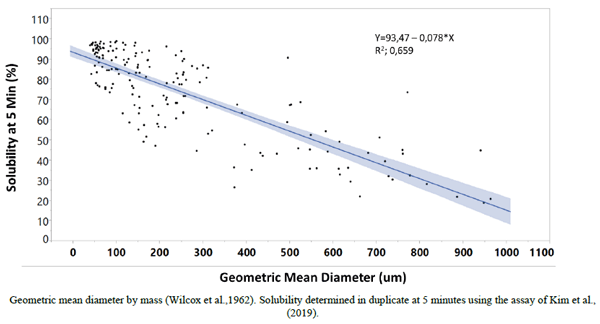I. INTRODUCTION
Calcium and phosphorus are two minerals of great concern to poultry nutritionists as a result of the relatively large quantities needed in the diet, and the adverse effects on bone formation, shell quality, and overall performance when inadequate amounts of these minerals are supplied. It is further difficult to discuss calcium supply in poultry diets without referring to phosphorus, since the dietary requirement of these two minerals has previously been shown to be interdependent (Hurwitz 1989; Coon et al., 2002; Proszkowiec-Weglarz and Angel, 2013).
Should plasma calcium or phosphorus concentrations decrease, synthesis of 1,25-dihydroxy cholecalciferol (1, 25(OH)2D3) increases and, in turn, promotes increased intestinal Ca absorption while renal excretion is decreased (Proszkowiec-Weglarz et al., 2013; Li et al., 2017). In broilers, when dietary calcium is increased, typically by increasing the inclusion of limestone, there is also a progressive decrease in phosphorus digestibility (Li et al., 2017). The primary mechanism whereby this occurs has been thought to be directly, or via formation of calcium-phytate complexes that reduce the digestibility of phytate-bound phosphorus (Tamim and Angel, 2004; Plumstead, 2008, Jing et al., 2018). Since the utilization of calcium and phosphorus is influenced by the concentration and digestibility of the other nutrients in the diet, common practice in broilers has been to maintain a ratio of calcium to available phosphorus (AvP) when specifying requirements of calcium and phosphorus. Conveniently, this ratio has been set at 2:1 Ca:AvP in broilers (NRC 1994; Aviagen, 2014; Cobb 2018). The obvious limitation of this approach is that the interdependence of calcium and phosphorus homeostasis in the bird is driven by the amount and ratio of these nutrients provided at tissue level and hence by the ratio of digestible calcium:digestible phosphorus in the diet; and not by the ratio of total calcium:AvP supplied in the diet. In recent years, several research groups have shown that calcium digestibility in broilers can vary dramatically depending on the calcium source provided, the solubility of limestone, as well as by the source of phytate and addition of phytase (Anwar et al., 2016; Angel, 2019; Kim et al., 2019, Taylor et al., 2019).
With the knowledge that the digestibility of total dietary calcium can be significantly altered by the aforementioned dietary factors, and that the form of calcium provided and absolute amount can alter phosphorus digestibility, the specification of calcium requirements for broilers as total calcium in the diet becomes obsolete, as does the adherence to a fixed ratio of total calcium:AvP. The need to better understand how to predict variation in calcium digestibility, and the influence of calcium on phosphorus digestibility becomes even more critical when considering the high incidence of lameness and bone abnormalities observed in the industry with over 1% of commercial broilers grown to heavy processing weights affected after 5 weeks of age (Wideman, 2015). A similar case can be made for commercial laying hens for which requirements for calcium are still specified on a total basis. Particle size and solubility of limestone are known to influence the availability of calcium to the hen and can alter shell quality and bone ash (Zhang et al., 2017). These authors also suggested that the daily calcium requirement of laying hens to maintain egg shell quality should be determined based on the solubility characteristics of the limestone. While breed nutrition recommendations for laying hens do specify the supply of a portion of limestone as coarse limestone grit, potential differences in the solubility characteristics of that grit are not considered when formulating to meet the calcium demand of the hen. This observation becomes increasingly important in the context of modern laying hens where, as a result of increasing length of production cycles, optimizing the utilization of dietary calcium sources as hens age is critical to meet demands for shell formation without compromising skeletal integrity and bird welfare.
a) Variation in limestone quality and in-vitro assessment thereof
In vegetable-based broiler diets, limestone can contribute over 50% of the total dietary calcium supplied to broilers, and in excess of 90% of the calcium consumed by laying hens. Given the previous observations by multiple research groups that limestone particle size and solubility can affect the utilization of calcium by broilers and laying hens, as well as phosphorus digestibility and phytase efficacy in broilers, it was of interest to characterise the observed variation in particle size and solubility of limestones used in commercial feed production in Europe to quantify differences in limestone quality used in commercial poultry diets.
II. METHODOLOGY AND RESULTS
A total of 255 limestone samples were collected from feed mills in 16 different countries on the European continent. Of these, 192 samples were classed as fine limestone with an average geometric mean diameter (GMD) of <1000 µm and 63 samples as limestone grit when the average geometric mean diameter (GMD) was >1000 µm. All limestone samples were analysed for moisture, and 9 minerals (calcium, copper, iron, magnesium, manganese, phosphorus, potassium, sodium, zinc). Limestone particle size was determined using a shaker and a set of 14 sieves plus the base pan using a sample of 100g of each limestone shaken for 10 minutes. The method for geometric mean diameter (GMD) of limestone particles by mass (dgw) was calculated using the equations described by Wilcox et al. (1962). Solubility of limestone was determined in duplicate using the dynamic solubility assay recently published by Kim et al., (2019). For fine limestone, solubility was determined at 5, 15, and 30 minutes. Solubility of limestone grit samples was determined at 30, 90, and 150 minutes.
Table 1 - Particle size, mineral analysis, and solubility of 192 fine and 63 grit limestone samples collected from 16 countries in Europe.

Results in Table 1 reflect the large variation in the quality of fine and grit limestone used in commercial feed mills across Europe. Of the 192 fine limestone samples analysed, calcium levels were generally high with an average of 37.82% with only 28 samples having <36% calcium. What is particularly striking is the lack of standardization of the GMD particle size of “fine” limestone used in poultry feed. While the average GMD was 248 µm, the standard deviation of 223 µm was almost as high as the average with a CV of almost 90%. Over 48% of the fine limestone samples had a GMD below 150 µm, and 30% below 100um, reflecting the very fine nature of limestone frequently used. While there was a significant correlation between the GMD particle size and solubility of the limestone at 5 minutes (Figure 1), there are many exceptions to this generalization. For example, two limestone samples originating in the Ukraine and Poland, with similar respective particle sizes of 299 and 285 µm GMD, can have dramatically different initial solubility at 5 minutes of 87% and 45% respectively. In a similar manner, two limestone samples from different quarries in Germany had very different average GMD particle sizes of 46 µm and 250um but both reached 94% solubility at 5 minutes. Similar examples can be drawn from the grit limestone samples analyzed with samples from Germany and Turkey having similar respective GMD particle size of 2523 µm and 2587 µm yet solubilising to 73% and 42% at the first time-point of 30 minutes. These examples suggest that the geology of the limestone rock, as well as the particle size fractions, can have a profound influence on the rate of solubility of the limestone. Consequently, one cannot define an optimal particle size limestone to achieve a given rate of solubility without understanding the specific solubility characteristics of the limestone sample over time.
Figure 1 - Correlation between solubility at 5 minutes and geometric mean diameter of 192 fine limestone samples collected from 16 countries in Europe.
b) Implications of differences in limestone particle size and solubility characteristics on calcium digestibility and phytase efficacy in broilers.
Several recent papers have investigated methods to determine ingredient calcium digestibility and described effects of limestone particle size on calcium and phosphorus digestibility and phytase efficacy (Proszkowiec-Weglarz et al., 2013, Anwar et al., 2016; Kim et al., 2018; Angel 2019; Kim et al., 2019). For example, in the paper by Anwar et al. (2016), fine (<0.5 mm) and coarse (1-2 mm) limestone had in-vitro solubility of 0.60% and 0.33% and true Ca digestibility coefficients of 0.43 and 0.71, respectively. These findings demonstrated for the first time in broilers that a positive correlation existed between limestone particle size and in-vivo calcium digestibility, with calcium digestibility being negatively correlated to limestonesolubility. Kim et al. (2018) also showed fine limestone (0.75 µm) to have a higher in-vitro solubility that was supported in-vivo by a higher gizzard pH in 28-d old broilers fed diets with 0.8% or 1% calcium. However, in that study, the adverse effects of the fine, more rapidly soluble limestone on calcium digestibility were only observed when diets had a lower calcium level (0.6%) and no phytase. Further publications by the same group, Angel, (2019), and Kim et al. (2019) have subsequently provided greater insight into the impact that differences in limestone solubility arising from different sources (geology of limestone), or different particle size, can have on calcium digestibility in broilers. When comparing limestone from the same source, a reduction in particle size from 0.8 mm GMD to 0.15 mm GMD reduced standardized ileal digestibility (SID) of calcium from 49.2% to 38.1% (Angel, 2019). Importantly, in the paper by Kim et al. (2019), differences in GMD particle size alone could only explain <40% of the observed differences in calcium digestibility from limestone; and differences in limestone geology and physical/chemical characteristics were equally important to particle size in their potential effects on calcium digestibility. This observation is supported by our findings in the European limestone survey above, that limestone particle size alone was not able to adequately explain the large variation observed in in-vitro solubility between different samples of limestone. Initial models by Kim et al. (2019) further showed that differences in calcium digestibility between limestones could be explained by the extent of solubility achieved at 15 and 30-minutes in-vitro, highlighting that limestone must be solubilised in the proventriculus/gizzard in order to be digested. In addition to differences in limestone characteristics, the group at the University of Maryland has also shown the phytate source to alter digestibility of calcium from limestone, with phytate from corn tending to be more reactive with calcium from limestone than when diets contained a mixture of corn and soybean meal (Angel, 2019).
While not the main focus of this paper, one of the outcomes of the recent research focus on calcium digestibility was that the solubility kinetics of limestone could potentially alter phosphorus digestibility to a far greater extent than the observed differences in calcium digestibility (Kim et al., 2018; Angel 2019; Kim et al., 2019; Taylor et al., 2019). Using one example from our laboratory, Taylor (2019) evaluated three different sources of limestone that had been standardized to a 0.8mm GMD, or simply included in the same diet at the commercial particle size supplied by each limestone company. For each limestone, increasing the particle size and thereby slowing down the rate of solubilisation increased phosphorus digestibility. Of equal importance was that phytase efficacy and in-particular, matrix values from phytase, were significantly affected by the source of limestone used in the diet and is supported by the previous findings of Kim et al., (2018).
The significance of these and other research on limestone and calcium digestibility in practical broiler diet formulations still needs to be better understood. One of the reasons why we may not have seen large differences in broiler performance when commercial feed mills use different limestone sources is that analysed calcium and phosphorus levels in commercial broiler grower and finisher diets are typically far above the birds’ requirements determined in more recent research (Jiménez-Moreno, 2013). However, given environmental pressures on reducing phosphorus excretion in broiler manure in some regions, as well as the recent trend of reducing calcium levels in commercial broiler grower and finisher diets, the frequency whereby broiler performance is compromised as a result of not accurately defining the amount of digestible calcium supplied in diets of broilers will likely increase in the future.
c) Implications of calcium digestibility and effects of limestone particle size and solubility characteristics in laying hens and broiler breeders.
Over short periods, commercial laying hens and broiler breeders are particularly resilient to small variations in calcium supply vs. that required for egg formation. This is as a result of homeostatic mechanisms designed to regulate the supply of calcium for shell formation in times of excess or deficiency relative to demand. For example, should the diet contain insufficient digestible calcium to maintain the calcium demand for shell formation, the subsequent reduction in ionized blood calcium (iCa) stimulates parathyroid hormone (PTH) that is designed to elevate blood iCa to the hen (Singh et al., 1986). However, the elevation of blood iCa through elevated PTH is in-part achieved through the initiation of medullary bone breakdown. If the dietary calcium deficiency persists over extended periods, the hen will start to break down structural cortical bone (Whitehead, 2004). Therefore, the trade-off that occurs when insufficient digestible calcium is provided is that the hen compromises the structural integrity of her skeletal system, which results in a shorter productive life of the hen since the scavenged cortical bone is not replaced. This is a much greater problem in commercial hens for table eggs than it is for broiler breeders, both as a result of the shorter laying cycle and lower egg output of breeders.
A further issue that arises when laying hens utilize calcium from their bone reserves, is that eggshell quality decreases as the hen utilises more calcium from her bones (Sauveur and Mongin, 1983). Eggshell breakages form a large proportion of economic losses incurred by egg producers (Hamilton et al., 1979). Therefore, the determination of calcium digestibility values for ingredients may pose a solution to mitigate the effects of inaccurate calcium formulation for laying hens.
Since limestone as an ingredient contributes in excess of 90% of the calcium consumed by the hen, any variation in the digestibility thereof can significantly alter the supply of calcium at tissue level. The in vitro solubility of limestone at a single time-point has been reported to be inversely related with its in vivo solubility (Zhang and Coon, 1997). Larger limestone particles with a lower solubility would reside in the gizzard longer, thereby increasing the in vivo Ca availability and improving egg shell quality and bone mineralization in the hen (Raoand Roland, 1989; Zhang and Coon, 1997; Zhang et al., 2017; Sinclair Black, 2019). However, in contrast to these observations in laying hens, Bueno et al., (2016) observed no effects of limestone particle size on egg characteristics and performance of broiler breeders post-moulting. However, this research was done in post-moult broiler breeders from 74-83 weeks and may not have been long enough feeding period to show effects of limestone particle size. Consequently, more research is therefore required to elucidate if limestone particle size is influential on calcium utilisation in broiler breeders that are restrict fed a single meal a day. In laying hens, there is little doubt that coarser particle limestone with lower solubility will be beneficial the for saleable egg output, and the maintenance of bone integrity. Based on this, commercial recommendations for laying hen nutrition have incorporated the provision of a certain percentage of total dietary limestone to be provided as “grit” with the balance of limestone being supplied as fine or powdered limestone. While the minimum/maximum particle size of grit was specified between 2mm and 4mm (Hyline, 2013; Decalb-Amberlink 2019), this does not consider potential variation in the solubility of grit as a result of observed differences in the geology or origin of the limestone. As was shown in the survey of limestone grit samples (Table 1), there was a large variation of what particle size is defined as “grit” in Europe, and equally large variation in the rate of solubility over time. This is illustrated in Figure 2 that depicts the rate of solubility of 5 samples of limestone within a narrow range in GMD particle size of 2145-2522 µm.
Figure 2 - Dynamic solubility of limestone grit sampled from 5 countries in Europe

The objective of supplying grit to laying hens is to reduce the rate of limestone solubilisation, and therefore slow down the delivery of dietary calcium to coincide with the period of shell formation later in the day/evening. The data in Figure 2 show that a limestone with 2522 µm can potentially solubilize in excess of 75% within 30 minutes in-vitroat a pH of 3.0. In contrast, a second limestone with almost identical GMD (2587 µm) only reached 42% solubility at 30 min. These two limestones would, therefore, potentially deliver calcium to the hen at very different rates and be less or more beneficial in meeting the objectives of a slow release of calcium for egg shell formation. Further, one of the objectives of still providing a proportion of “fine” limestone in laying hen diets is to meet the rapid demand for calcium required to replenish the medullary bone supply in the morning. Based on many of the limestone grit samples analysed solubilizing over 50% at the first time-point of 30 minutes, one could speculate if there is indeed a need for a separate source of “fine limestone”, and is the subject of ongoing research in our laboratory.
In terms of determining calcium digestibility in laying hens, a further aspect that should be taken into account is the hens ability to rapidly alter calcium digestibility based on the time of day, or rather the physiological demand for blood iCa for shell formation. This was recently investigated in our laboratory with results showing that ileal calcium digestibility changed from 54.61% at 3h post oviposition to 64.77% 11h after oviposition, and during the time of peak shell formation (Sinclair-Black, 2019). This finding has several implications, foremost that when determining calcium digestibility for the purpose of developing matrix values for feed formulation, the timing relative to oviposition time of the hen can dramatically alter results.
Further, from a commercial perspective, while calcium requirements of the hen are specified as total Ca to be supplied/day, the timing of when that calcium is supplied will greatly affect its utilization and subsequently the absolute total amount required. This again reiterates the limitations of continuing to specify calcium requirements and feed formulation on the basis of total calcium.
ACKNOWLEDGEMENTS: This work was, in part, supported by Danisco Animal Nutrition, DuPont Industrial Biosciences and Chemuniue PTY LTD, South Africa.
Abstract presented at the 30th Annual Australian Poultry Science Symposium 2020. For information on the next edition, click here. 










